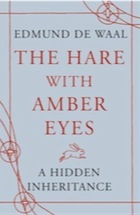Edmund de Waal, a British potter, describes the collection of netsuke, Japanese miniature sculptures, belonging to his uncle that he will one day inherit. Thus begins a journey through history, following the collection, that takes us from 1870s Paris to early twentieth-century Vienna and finally back to Tokyo.
 This thread of a premise, which in many hands would peter out after a few pages, is masterfully unwound by De Waal, revealing layers of inquiry on the sensuality of the netsuke and of art in general; the meaning of the act of collecting; nationality, belonging, and acceptance in the midst of momentous historical events; and personal destiny. It is all bound up in deep questions of identity for this heir to both a collection of remarkable objects and a weighty family history.
This thread of a premise, which in many hands would peter out after a few pages, is masterfully unwound by De Waal, revealing layers of inquiry on the sensuality of the netsuke and of art in general; the meaning of the act of collecting; nationality, belonging, and acceptance in the midst of momentous historical events; and personal destiny. It is all bound up in deep questions of identity for this heir to both a collection of remarkable objects and a weighty family history.
A large part of the success of this work is De Waal’s voice. He has a calm, precise style that is a pleasure to read – exactly the writing one would expect from someone who has dedicated his life to the patient, unforgiving craft of pottery. He has a keen sense of observation, a vivid way of portraying places distant in geography and time. In a world where we are so frequently exposed to the pandering and the garrulous, De Waal’s tone is confidential, rarified. It reflects exactly the qualities of the netsuke themselves.
 In terms of content, what keeps The Hare With Amber Eyes compelling is that it is a genealogical adventure tale. There is an extraordinary gallery of characters, from the Parisian “dandy scholar” Charles Ephrussi to the Viktor, the accidental heir to the family’s enormous financial operations, to the fiercely determined legal scholar and poet, Elisabeth. One is immersed in the life of late nineteenth-century Paris, of the decaying Austrian Empire, of post-war Japan. One crosses the paths of Manet and Morisot, of Hofmannsthal and Rilke. One learns a great deal about art and history, without a moment of pedantry, simply through an exploratory process governed by sensitivity.
In terms of content, what keeps The Hare With Amber Eyes compelling is that it is a genealogical adventure tale. There is an extraordinary gallery of characters, from the Parisian “dandy scholar” Charles Ephrussi to the Viktor, the accidental heir to the family’s enormous financial operations, to the fiercely determined legal scholar and poet, Elisabeth. One is immersed in the life of late nineteenth-century Paris, of the decaying Austrian Empire, of post-war Japan. One crosses the paths of Manet and Morisot, of Hofmannsthal and Rilke. One learns a great deal about art and history, without a moment of pedantry, simply through an exploratory process governed by sensitivity.
The device of letting the process of research drive the narrative allows us to follow De Waal’s questions and discoveries through his footsteps; we learn of the long, obsessive digressions of his research, we share the aesthetic pleasure of leafing through the heavy grain of old art reviews, of examining the stone motifs on old palaces and imagining the physicality of objects. It is one of those books where one takes pleasure in not just what is being told, but simply in being in the company of the author.
The Hare With The Amber Eyes won the 2011 Ondaatje Prize (see article at guardian.co.uk). A U.S. edition was published by Picador earlier this month.
